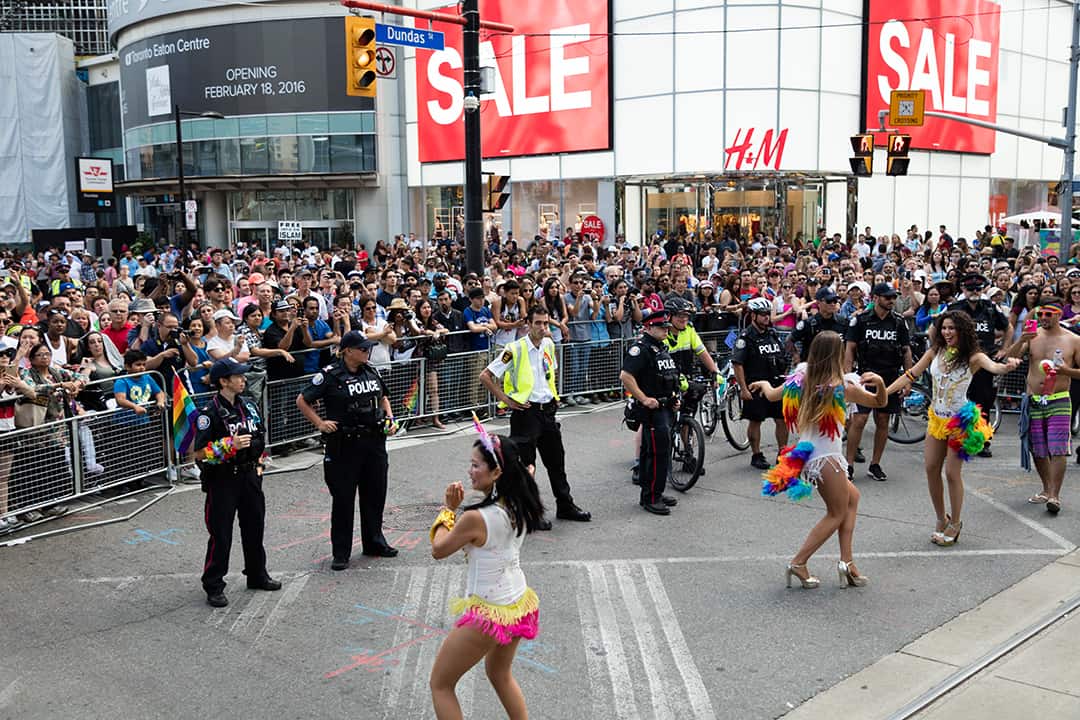“Everyone in this space, sit down,” said Alexandria Williams, the co-founder of Black Lives Matter Toronto. “This is your space.”
This year’s Toronto Pride parade was halted by a sit-in protest organized by Black Lives Matter TO. Citing Pride Toronto’s erasure of Black infrastructure, the group made the following demands: full funding for community stages — including the reinstatement of the South Asian Stage — continued space and logistical support for Black Queer Youth, and prioritizing the hiring of Black trans women and Indigenous peoples at Pride Toronto.
Of these demands, the most controversial was the call for the removal of all police floats from the parade. Sparking various reactions from members of the LGBTQ+ community and police officers themselves, many claim that such a demand represents the exclusion of police officers from Pride, and that the protest as a whole was disrespectful to the LGBTQ+ community.
Despite these criticisms, Pride should be an open space for everyone to express their personal identities. Black Lives Matter deserves a space in Pride and should be prioritized over police officers.
The Toronto Star recently published an open letter from Chuck Krangle, an openly gay police officer, expressing his feelings of exclusion. In his letter, Krangle wrote about dealing with the fear of persecution, coming-out, and attending the Pride parade for the first time in 2016 with the support of his co-workers. He outlined the experiences of LGBTQ+ police officers, and their struggle to gain a workplace free of discrimination and bias.
“Members of police services, and their employers […] have just as much right to participate as any other group,” wrote Krangle. “Police Officers are significantly represented in the LGBTQ community and it would be unacceptable to alienate and discriminate against them and those who support them.”
What Krangle fails to recognize in his letter is that his occupation is a choice. He can still attend Pride without his badge and uniform. Blackness, on the other hand, is not a choice and cannot be shed in the same manner as a uniform.
Pride itself originated as a riot led by trans women of colour in response to the police raid of the Stonewall Inn. At the time, it was suspected that the New York Police Department was specifically targeting gay clubs. Because Pride originated as a movement of resistance against oppressive police force, it is antithetical for police to have floats in the parade, as Pride Toronto should respect both the history of Pride and the individuals who made Pride possible.
Despite the representation of Black and queer-identifying police officers within the force, as well as those who do not perpetuate violence against minorities, the very presence of police continues to incite fear in racialized minorities. It is crucial, therefore, that we recognize the institution of the police force as a symbol of oppression; members of racialized minorities continue to be murdered and harassed at the hands of police. For example, shortly after the Black Lives Matter protest in Toronto, Alton Sterling and Philando Castile were both killed by police officers in the United States.
[pullquote-default]Because Pride originated as a movement of resistance against oppressive police force, it is antithetical for police to have floats in the parade, as Pride Toronto should respect both the history of Pride and the individuals who made Pride possible.[/pullquote-default]
It is not the case that police officers should be excluded from Pride entirely. If police officers are to participate in Pride in any capacity, they should fulfill the role of promoting public safety — something that many marginalized communities have been deprived of.
Instead of marching in the parade, the police should take actions such as protecting attendees from hate crimes, preventing hate groups from entering the vicinity of Pride events, and monitoring public transit routes leading to and from the parade to ensure the safety of individuals travelling outside the boundaries of Yonge Street. Police participation in Pride should prioritize the protection of queer people — especially those of colour — instead of taking up their space.
The reception of Black Lives Matter at Pride was far from welcoming. “Don’t boo,” Alexandria Williams said in response to spectators of the sit-in. “[This is] the only time I have ever heard this from a community who should understand what it feels like to be oppressed.”
[pullquote-features]Pride belongs to Black Lives Matter more than it does to the region’s police officers.[/pullquote-features]
Members of the LGBTQ+ community opposed to Black Lives Matter’s actions should seek to understand the position of the black community, especially since both have faced similar systemic oppression at the hands of police. They should also recognize that Black Lives Matter is an intrinsic part of Pride. A common misconception — one that Williams challenges when she tells the protestors that Pride is their space — is that Black Lives Matter and the LGBTQ+ community are two completely separate entities. This assumption oversimplifies and ignores the numerous intersections of class, race, sexual orientation, and gender identity that make up the LGBTQ+ community — all of which should be recognized by Pride Toronto.
Pride belongs to Black Lives Matter more than it does to the region’s police officers. We must not condemn the actions of Black Lives Matter, but instead we must condemn the violent actions perpetrated by the police against people of colour. It is the systemic violence against black people that forces Black Lives Matter to protest, halt the parade, and make demands that would lead to inclusion and safer spaces for numerous marginalized communities. For these reasons, the removal of police floats is crucial to creating an inclusive Pride.
Avneet Sharma is a second-year student at Trinity College studying English and Book and Media Studies.


